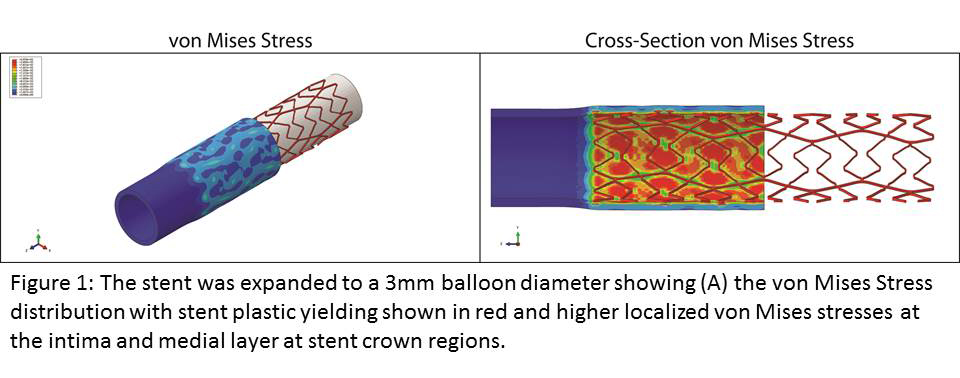Back to 2015 Annual Meeting Abstracts
Finite Element Analysis of a Balloon Expandable Stent and Superior Mesenteric Arterial Wall Interaction
Martyn Knowles1, Tre R. Welch1, Carlos H. Timaran1, R. James Valentine1, Cheng Jen Chuong2, Robert C. Eberhart1, Surendranath VeeramReddy1, Alan Nugent1, Joseph A. Forbess1
1University of Texas Southwestern, Dallas, TX;2University of Texas Arlington, Dallas, TX
INTRODUCTION: An iCAST covered balloon-expandable stent (Maquet Getinge Group, Hudson, NH) has been used in the superior mesenteric artery (SMA) to treat a variety of pathology, and most recently for visceral stenting in fenestrated endovascular aortic repair (FEVAR). Stenting has primarily been investigated by bench studies involving finite element analysis in the coronaries; however, further explanation of the mechanical behavior has not been performed. This study examined the atrium stent expansion using a pseudo-balloon and then a second simulation expanding the stent into a theoretical SMA.
METHODS: A 3D-Atrium Stent model was created in Solidworks 2014 (DS Solidworks Corp., Waltham, MA). A laser cut tube was fabricated to strut dimensions and stent length, 38 mm, taken from microscopic pictures. A straight arterial model of 40 mm in length was created using lumen dimensions from CT scanned data. The stent was inserted to 40% coverage within the SMA. These models were imported and meshed in Abaqus 6.13 (Dassault Systemes Simulia Corp., Providence, RI). Surface to surface contact between the stent and the balloon, self-contact, and stent to arterial lumen was used between the stent using Lagrangian Penalty Method. Nonlinear hyperelastic material properties were derived using a 5-parameter strain energy function in Abaqus 6.13. 316L stainless steel stress strain data was used for the stent. The balloon and SMA was constrained to expand only in the radial direction, uθ=uZ=0. The boundary conditions, uθ=uZ=0, were applied to the stent at the central midpoints. The stent and stent in artery simulation process occured in 4 steps: (1) Stent Crimping, (2) Stent Relaxation, (3) Stent Expansion, and (4) Stent Relaxation.
RESULTS: The analysis showed plastic yielding of the struts at the crown sections causing the stent to “lock” into a fixed position that was determined by using the von Mises yielding criterion and analyzing the strain formulation throughout these regions. Elastic recoil does occur in the model to be <5% and foreshortening <5%. The crown regions show a “fish scaling” effect. Higher stresses were generated at the regions of stent contact between the stent and the intimal surface. The von Mises stress range was 6-42 kPa with the outside of the artery showing a stress range of 3-6 kPa. The expanded stent into the arterial vessel shows a mapped stress distribution <2 MPa along the luminal wall for circumferential, radial and axial stresses.
CONCLUSIONS: The atrium stent plastically deforms to a fixed position with minimal elastic recoil without arterial interactions. More recoil is experienced with the addition of the SMA. The use of finite element analysis has shown the stent can retain an open position for blood flow while maintaining higher stress distributions localized at the crown regions and edge of the stent in contact with the lumen of the intimal layer. The impact of these stresses is the focus of continuing research. The expansion and relaxation of the stent, with areas of high stress, could lead to an inflammatory response and possible intimal hyperplasia.
Back to 2015 Annual Meeting Abstracts
